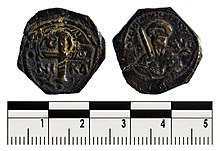Tancred, Prince of Galilee
| Tancred | |
|---|---|
Roman Catholic |
Tancred (c. 1075 – December 5 or December 12, 1112) was an
Biography
Early life
Tancred was a son of Emma of Hauteville and Odo the Good Marquis. His maternal grandparents were Robert Guiscard and Guiscard's first wife Alberada of Buonalbergo. Emma was also a sister of Bohemond I of Antioch.
First Crusade
In 1096, Tancred joined his maternal uncle Bohemond on the

In 1097, the Crusaders divided their forces at Heraclea Cybistra and Tancred entered the Levant by passing south through the Cilician Gates.[3] He displayed the skills of a brilliant strategist by seizing five of the most important sites in Cilicia Pedias, which included the ancient cities of Tarsus and Adana, the great emporium at Mopsuestia, and the strategic castles at Sarvandikar and Anazarbus.[4] The last three settlements were annexed to the Principality of Antioch. During their fourteen-year occupation of Anazarbus the Crusaders built the magnificent donjon atop the center of the fortified outcrop. At Sarvandikar, which controlled the strategic Amanus Pass, Tancred imprisoned Raymond of Saint-Gilles in 1101/02.[5]
He assisted in the
Regent of Antioch
In 1100, Tancred became regent of Antioch when Bohemond was taken prisoner by the

In 1108, Tancred refused to honour the
In 1110, he brought
The
In fiction

Tancred appears as a character in
Tancred also appears as one of the Crusade leaders in Sir Walter Scott's novel Count Robert of Paris who returned to Constantinople from Scutari to ensure a fair contest between Count Robert and his challenger. The novel Tancred, or the New Crusade by Benjamin Disraeli centres around the adventures of an imagined modern descendant and namesake of the Prince of Galilee. Rossini's opera Tancredi is based on Tasso, via Voltaire's play Tancrède of 1759.
Notes
- ^ Alternatively, it is claimed that the first crusader to enter Jerusalem was Ludolf of Tournai,[6][7][8] and he was followed by his brother Englebert.[citation needed]
References
- ^ Ernest Barker (1911). "Tancred (crusader)". In Chisholm, Hugh (ed.). Encyclopædia Britannica. 26. (11th ed.). Cambridge University Press. pp. 394-395.
- ^ Grabois, Aryeh (2006). In The Crusades - An Encyclopedia. pp. 1143-1145.
- Wikidata Q112759923.
- ISBN 0-88402-163-7.
- ^ Matthew of Edessa, Recueil des historiens des croisades, Documents arméniens, vol. 1, reprint: Farnborough, 1967, p. 57.
- ISBN 978-1-4051-2377-8.
- ^ J. S. C. Riley-Smith, Jonathan Phillips, Alan V. Murray, Guy Perry and Nicholas Morton (2016). A Database of Crusaders to the Holy Land, 1095–1149. "Lethold of Tournai".
{{cite web}}: CS1 maint: multiple names: authors list (link) CS1 maint: numeric names: authors list (link) - ^ Asbridge, Thomas (2004). "The First Crusade, A New History," Oxford University Press. p. 315.
- ^ a b c d Nicholson, Robert Lawrance (1940). Tancred: A Study of His Career and Work in Their Relation to the First Crusade and the Establishment of the Latin States in Syria and Palestine. The University of Chicago. pp. 7, 94–95.
- ^ Smail, p. 28
- ^ Lock 2006, p. 30.
- ^ Runciman 1987, pp. 126–126.
Sources
- Edwards, Robert W., The Fortifications of Armenian Cilicia: Dumbarton Oaks Studies XXIII, Washington, D.C.: Dumbarton Oaks, Trustees for Harvard University (1987). ISBN 0-88402-163-7
- Lock, Peter (2006). The Routledge Companion to the Crusades. Routledge. ISBN 9-78-0-415-39312-6.
- Robert Lawrence Nicholson, Tancred: A Study of His Career and Work. AMS Press, 1978.
- Peters, Edward, ed., The First Crusade: The Chronicle of Fulcher of Chartres and Other Source Materials, (Philadelphia: University of Pennsylvania Press, 1998)
- Runciman, Steven (3 December 1987). A History of the Crusades. CUP Archive. pp. 125–126. ISBN 978-0-521-34771-6. Retrieved 20 February 2024.
- Smail, R. C. Crusading Warfare 1097–1193. New York: Barnes & Noble Books, (1956) 1995. ISBN 1-56619-769-4
- Ferdinandi, Sergio (2017). La Contea Franca di Edessa. Fondazione e Profilo Storico del Primo Principato Crociato nel Levante (1098-1150). Pontificia Università Antonianum - Rome. ISBN 978-88-7257-103-3.
External links
- (in English) Gesta Tancredi
 Texts on Wikisource:
Texts on Wikisource:
- "Tancred". Collier's New Encyclopedia. 1921.
- "Tancred". Encyclopedia Americana. 1920.
- "Tancred". The New Student's Reference Work. 1914.
- "Tancred (d. 1112)". Encyclopædia Britannica (11th ed.). 1911.
- "The American Cyclopædia. 1879.

